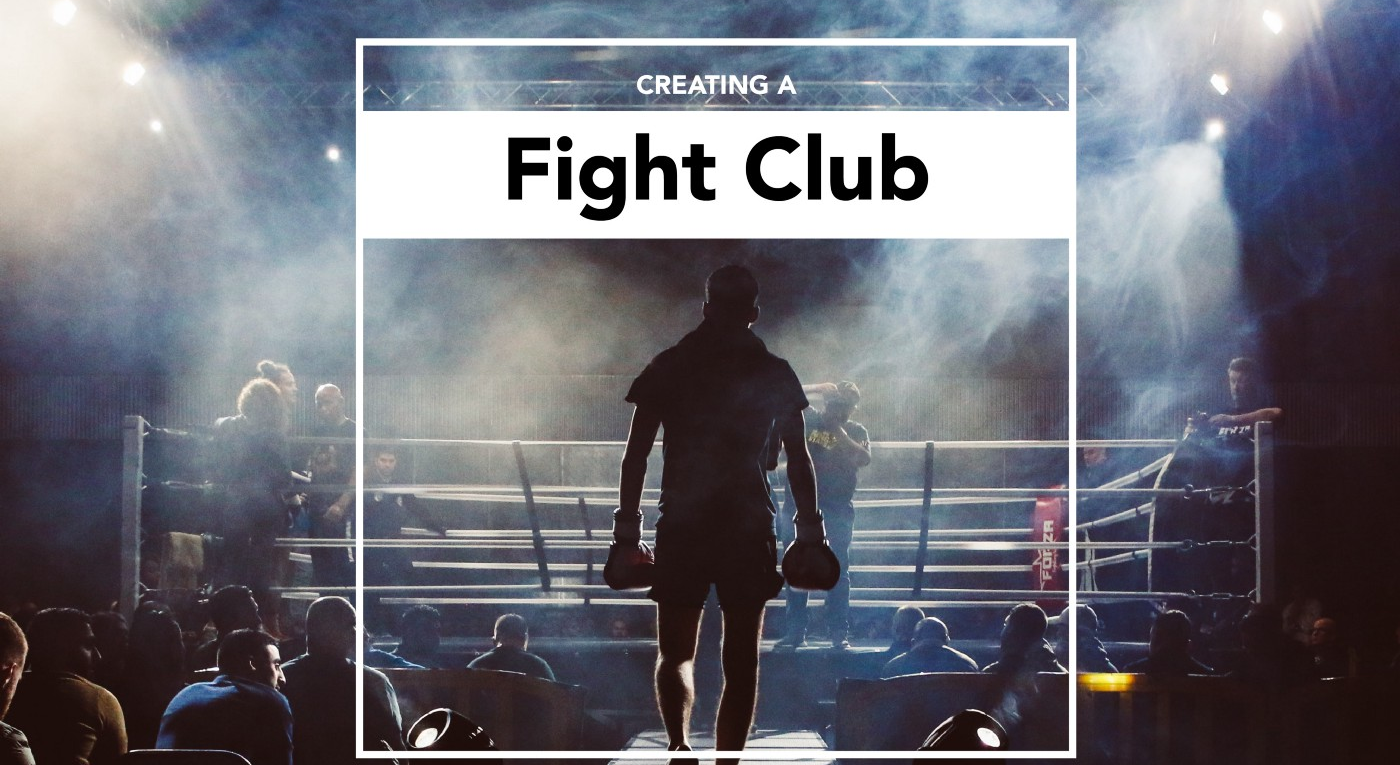Ok, so I may have misled you a bit. This isn’t about a true Fight Club. It’s more like a weekly Round Table Discussion. But the clickbait worked, didn’t it?
Conflict For The Sake of Commitment
A little over a year ago I was making a concerted effort to build up the discipline of Product Strategy at Covenant Eyes. I wasn’t alone though. My boss was extremely supportive of this effort and I had a Strategist that was working alongside me. In fact, he would later take over this area of work altogether. But that’s a story for another time. Anyways, our forward progress was stalling due to problems we were running into.
Strategy, by nature, is disruptive, distracting, and can cause angst within an organization. The more we worked in Strategy, the more dirt it kicked up. Long standing alliances, perspectives, beliefs, and opinions were being stirred up. In order to move forward we needed people in the company to be unified and to reach commitment. At the time I was re-reading a book by Patrick Lencioni and came across something that got me thinking.
Lencioni states that, within a team, in order to have commitment, you need conflict, in order to have conflict, you need trust. We wanted to get to commitment but first we need a trust-worthy space for conflict. We needed a professional “Fight Club” of sorts. We knew there were competing perspectives and opinions on a variety of subjects but we hadn’t provided the space to take the gloves off and have at it.
Goals
- Surface areas of conflict within the organization that aren’t being addressed.
- Create a safe, neutral environment where people can be honest and open without fear of repercussion.
- Provide a platform for people to share their concerns, perspectives and opinions with audiences they wouldn’t normally be able to.
- Discuss multiple sides to particular issues instead of just one side.
- Move towards alignment and commitment within the organization.
Introducing The Round Table Discussion
I came up with the idea of a Round Table Discussion. The idea was to create a time-boxed event to facilitate conflict. Every Round Table would have a topic, a facilitator, participants, and a structure.
Setting Topics
Topics centered around areas on confusion and disagreement. These topics were easy to spot within the organization. But in case we didn’t see them, we gave people the opportunity to send them our way.
We created a Slack Channel for the organization and make it a goal to send out the topic a week in advance. This gave people the opportunity to collect their thoughts or data around the subject before coming to the Round Table.
Choosing a Facilitator
In the beginning, I was the facilitator for most of the topics. Within the first month or so, we had a couple of difficult topics that required a facilitator with more weight and authority. In those situations we had an executive facilitate instead. Eventually, the Product Strategist would take over facilitation for nearly all Round Tables. There were a few things vital to keep in mind for anyone facilitating the Round Table:
- Unbiased. The facilitator cannot take a side on a topic. They are there to moderate, not participate.
- Set The Stage. It was the facilitator’s job to explain the topic, the rules of engagement, and intended outcomes from the discussion.
- Control the Time. This means controlling the time each person has to talk. I opted for less than 2 minutes, at which time I was in my rights to cut a person off.
- Manage the Talking Stick. Each person in The Round Table has an equal voice. Execs and managers don’t get special treatment. Everyone to raise your hand and be called on in order to engage in the discussion. (This proved to be crucial for engagement).
- Restate Responses. 2 Minutes is a long time. The facilitator has to be able to recap back to the audience in a few second the gist of a response; “So what I heard was this. Is that right?”
Participants
Everyone from the organization is encouraged to attend and engage in this discussion. It doesn’t matter your role in the company. Your voice and perspective is valuable and you have an opportunity to share it. This is not for leaders only or non-leaders only. This is for everyone. By participating in the Round Table, it put people in the same room that rarely interacted with each other.
The Structure
The basic structure for Round Table Discussions:
- Review Rules of Engagement — 5 min (Most important part)
- Introduce Topic for Discussion and Context — 5–10min
- Moderated Discussion—2 min per person. 40 min in total (Raised Hand in Zoom created a line for participants)
- Wrap Up—5–10 min (Discuss any next steps, outcomes, or plans to address issue)
That structure seems simple but it shouldn’t be overly complicated. Your participants will freely create the discussion and disagreement. You don’t have to force that, you simply need to provide a space for respectful conflict.
Rules of Engagement
Etiquette and Chatham House Rule aka ‘Rules of Engagement” are the most important part of this whole thing. If you don’t get this right, you will do more harm than good. You won’t have commitment and you will break trust of many people.
These rules create the space of trust you need. Remember, in order to get commitment, you need conflict. In order to have conflict, you need trust. Without trust, you will not get the rich, respectful conflict that you need. If everyone follows these rules, you can have trust. If these are broken, you lose trust.
Rules of Etiquette
- Everyone is an Equal. We are discussing ideas, perspectives, and opinions. You position does not matter for these discussions.
- Raise Your Hand: “Raise Hand” in Zoom (✋🏼) when you want to chime in.
- Wait To Be Called On: Wait until it is your turn to talk and you are called on by the facilitator.
- Inquiry Over Advocacy: Listen to why someone believes different than you. Don’t spend all of your time advocating for your own perspective.
- Be Concise: You have 2 minutes so be mindful of your time. Give others a chance to contribute.
- Be Respectful: Other people’s perspectives matter too. Treat them as such.
- Avoid Logical Fallacy: Weak reasoning leads to weak understanding and buy-in.
- Show Integrity: Don’t lie or misrepresent yourself, others, or ideas to make your point.
Chatham House Rule
Adapted from Chatham House
- Off The Record: Round Table Discussions are never be recorded.
- Anonymity: Identity of participants should not be shared.
- Immunity: No repercussions for sharing your perspective or opinions. This is something that execs and managers have to agree to support.
- No Gossip: When the Round Table is over you cannot discuss who was there and what they said outside of the meeting.
Conclusion
We have been running Round Table Discussions for over a year and a half. In that time we have not broke the Rules of Engagement. As soon as those are broken, this experiment of ours is over. If someone is disciplined or fired for something they said in a Round Table, trust is gone. If someone hears gossip about something said in the Round Table then they know their own words can be used in gossip too. So far, we have maintained trust. We are still able to have conflict and commitment as a result. We are better off because of this.
Round Table Discussions have been a key component to getting buy-in and commitment for Product Strategy and Company Culture improvements. We have been able to work through difficult conversations that had been festering for years. The culture aspect is something didn’t anticipate. We were unaware that many of our obstacles related to Strategy we actually due to unresolved cultural disagreements. Round Tables have helped in making a healthier company culture in ways we couldn’t have imagined.
I hope this helps you start your own Fight Club.








